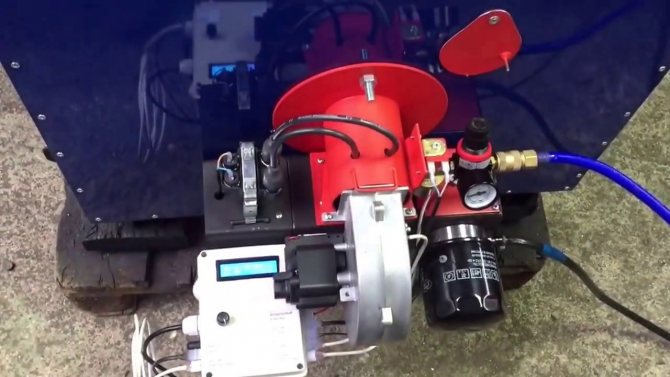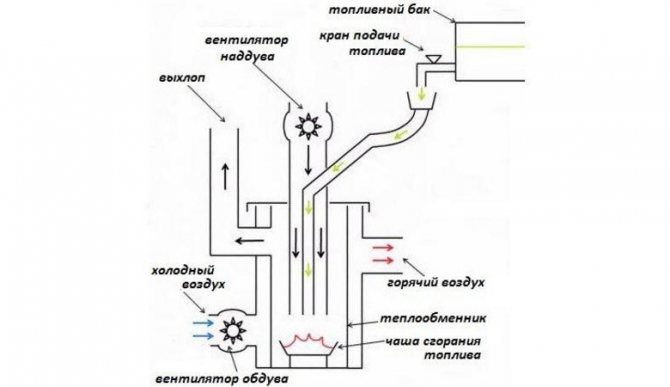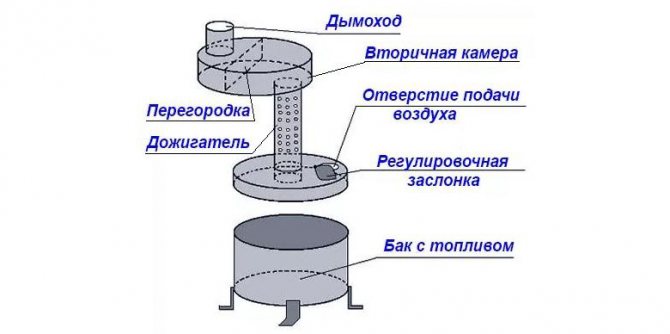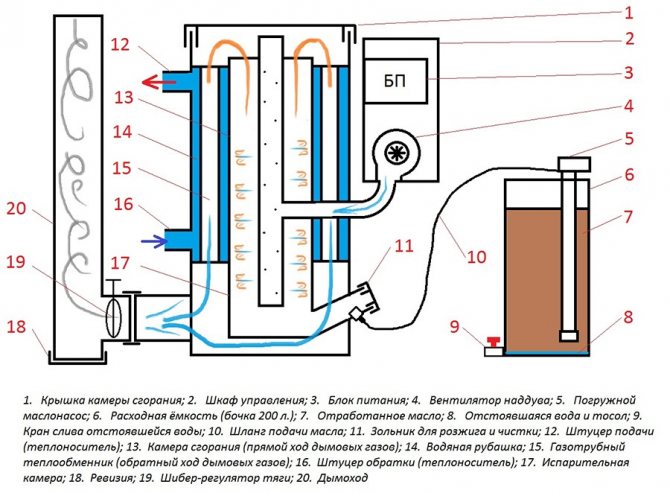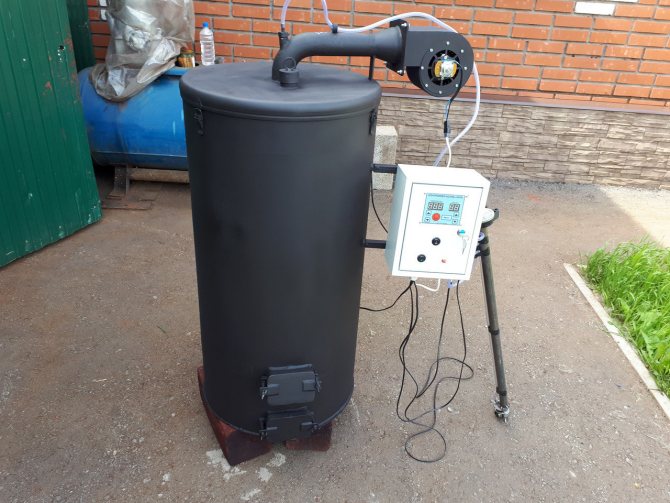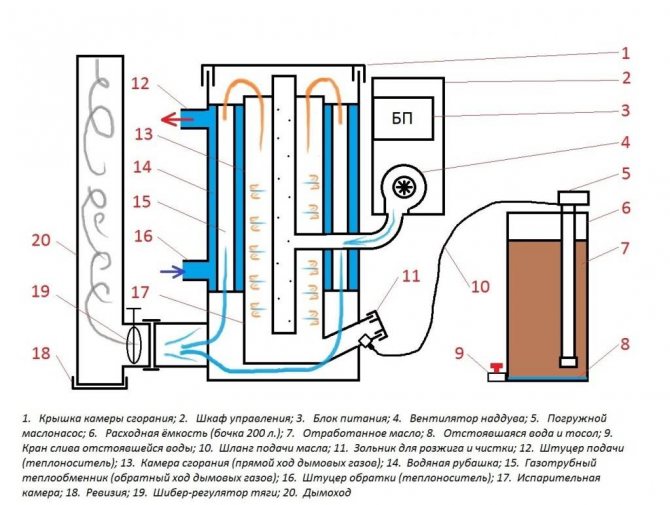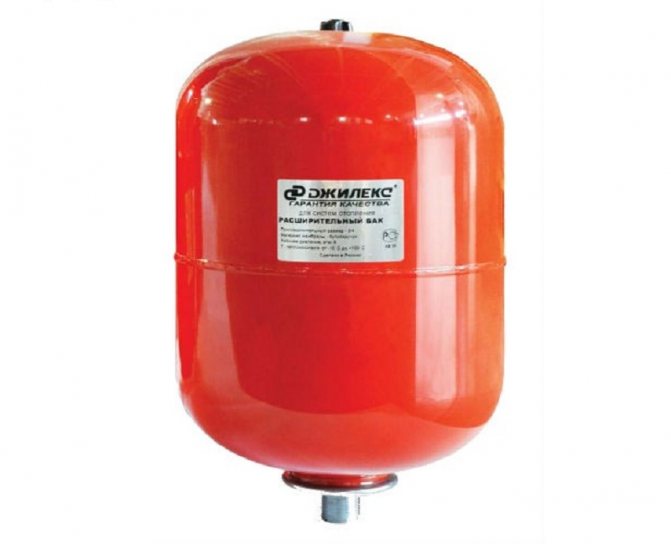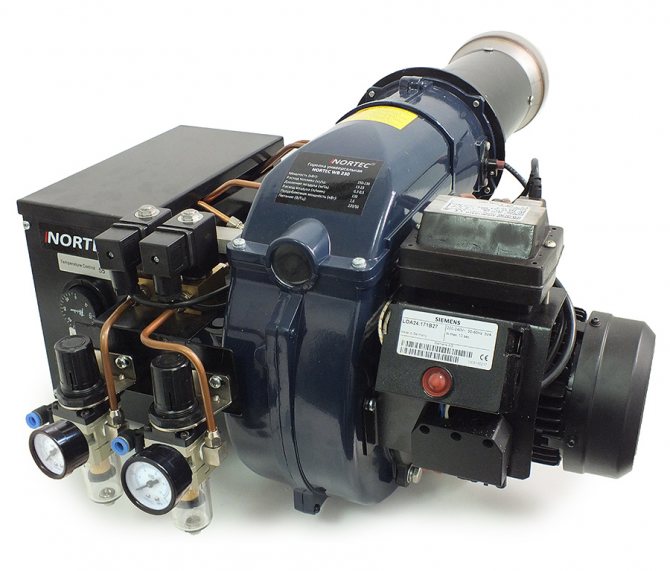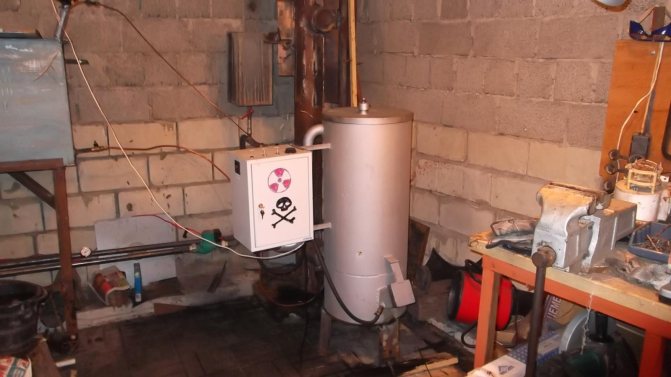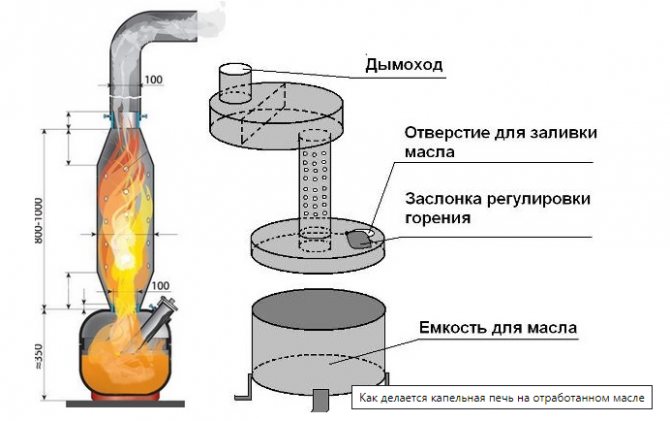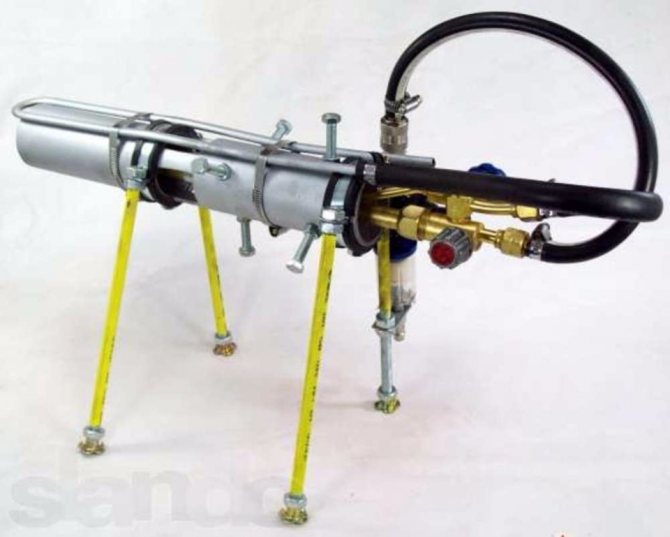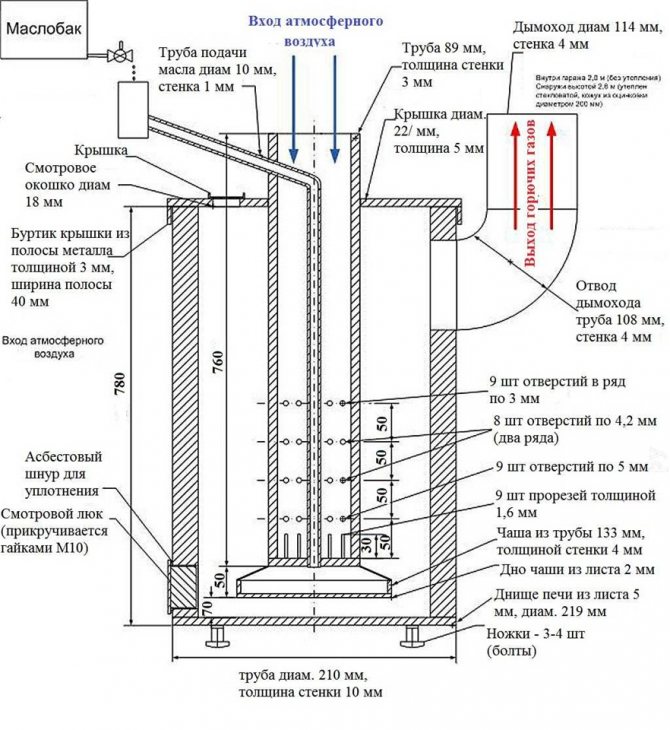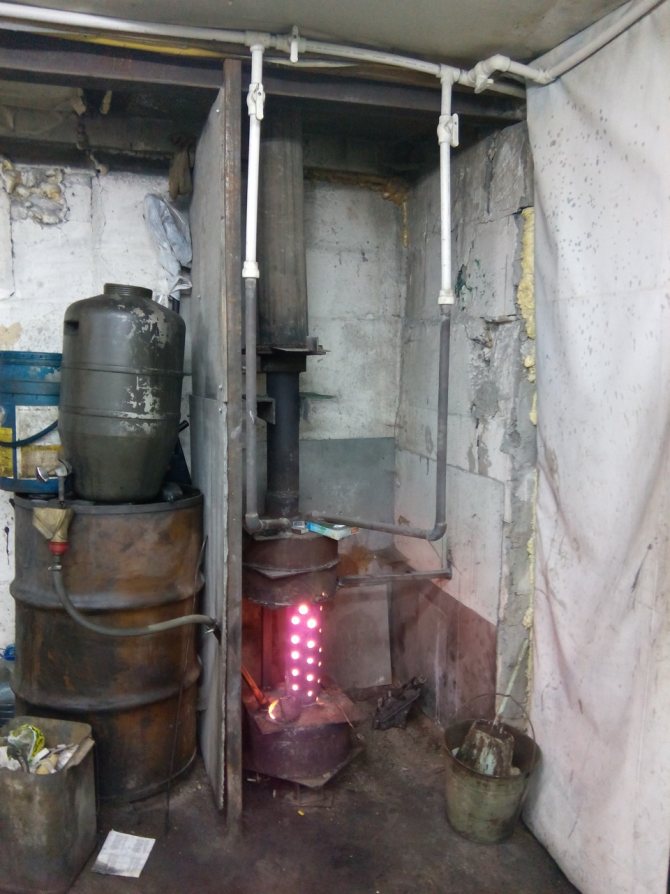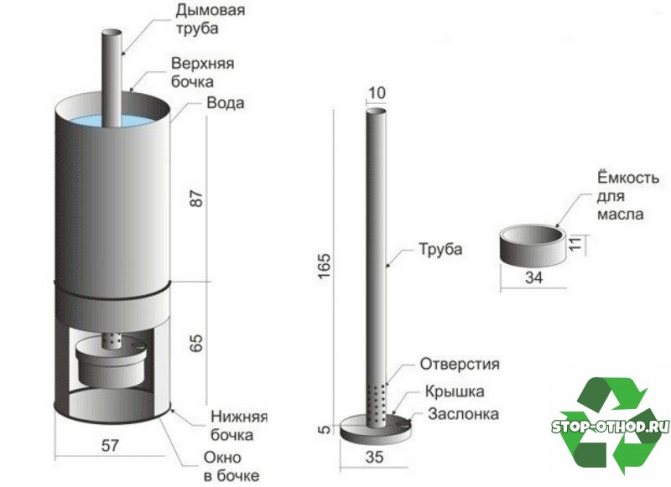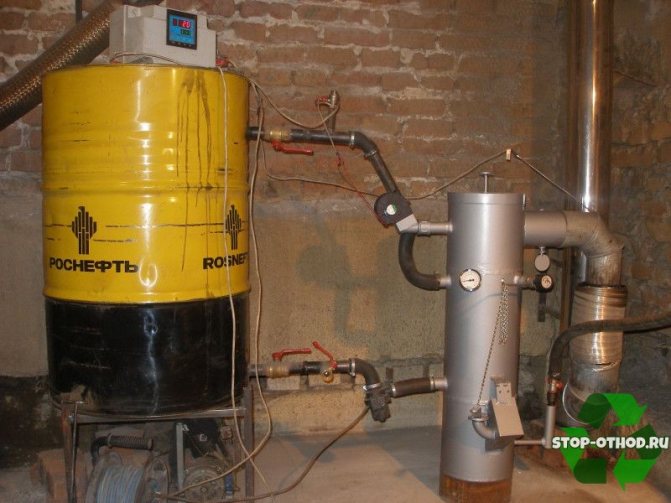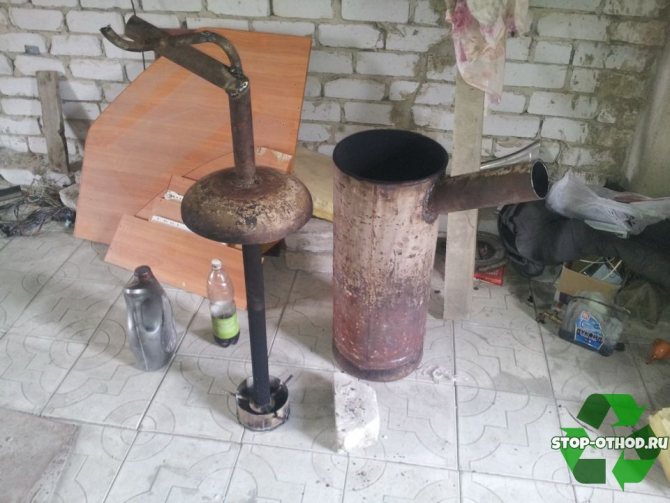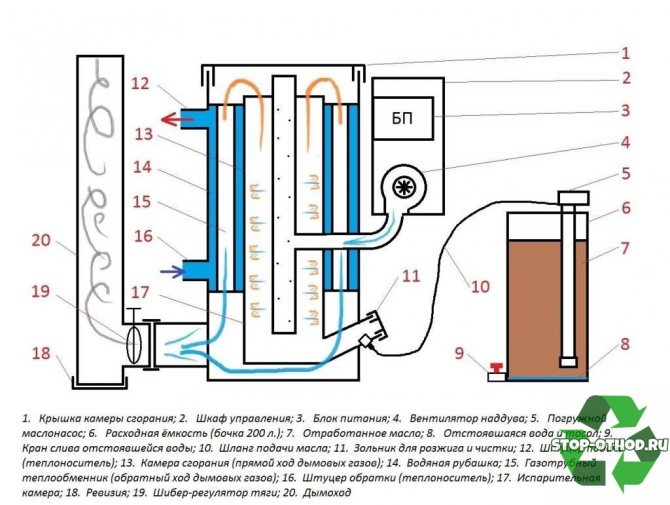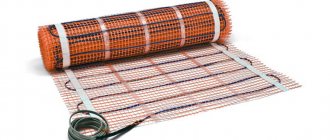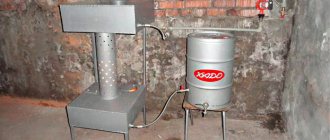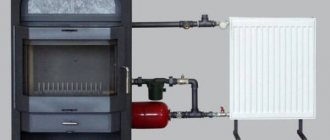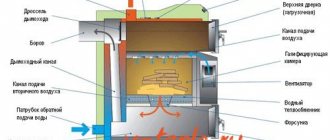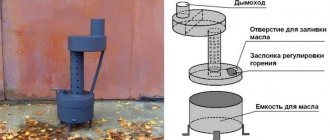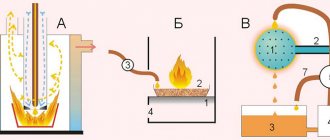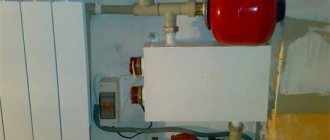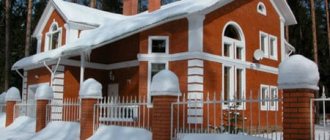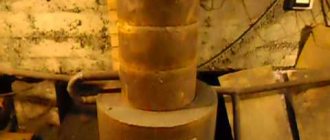A working boiler with a water circuit is used to heat rooms in which there is technical oil that has long served its life.
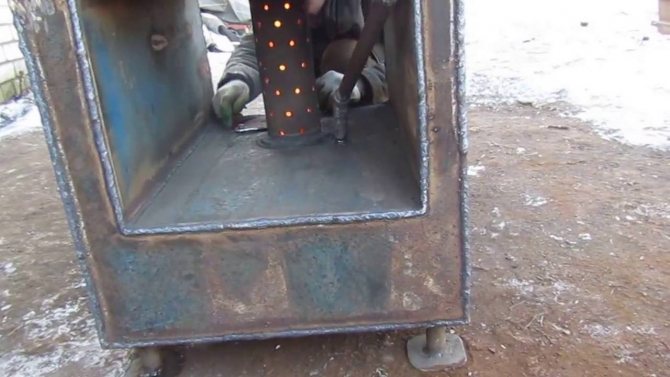
Installation helps to save on fuel
Often, such designs are actively used to provide heat in warehouses, private baths. Some even install such boilers in their country houses.
One of the main advantages of using such a unit is the low cost of fuel. Car service owners are ready to gladly part with working off for a pittance. But only with the condition of self-export.
Boiler working principle
A waste oil boiler operates from a number of points. The installed oil sludge takes the required amount of fuel from the supply tank and transfers it to a special evaporation chamber.
In fact, it is a standard metal pipe. It is worth noting that for this purpose it is best to take a pipe with rather thick walls so that it can withstand the highest possible temperature.
To make the waste oil suitable for use in the heating system, it is brought to a temperature of 40 degrees. When fuel hits the bottom of the chamber, it gradually begins to evaporate, becoming oil vapor, which subsequently rises into the combustion chamber.
It is imperative to take into account when assembling such a boiler that any system that operates on waste oil must be equipped with a heating system. If you neglect this moment, then the used oil will not become the required temperature.
This will lead in the future to poor ignition of the fuel, it will not be able to burn out in full. The same fact will cause the formation of a large amount of soot, from which the boiler will have to be constantly cleaned so that it does not fail.
In order for the combustion chamber to work normally, a so-called perforated air duct is added to its design, through which additional air comes in due to a special blower fan. Further, the oil vapors will mix with air and form a certain mixture that can completely burn out. As a result, the coolant of the heating system will be warmed up to the full, and the combustion products will go into the chimney.
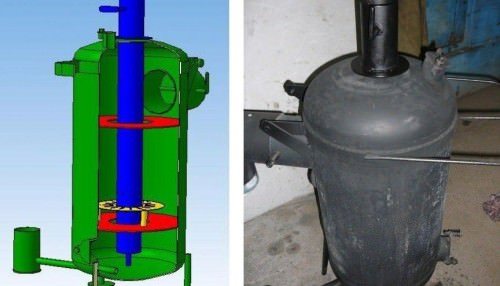

It is imperative to take into account when assembling such a boiler that any system that operates using waste oil must be equipped with a heating system.
Equipment performance analysis
A conventional boiler with a water circuit has the same selection parameters as similar models using other types of fuel. These include the nominal and maximum power of the equipment, the volume of the heat exchanger, the presence of control elements and safety groups.
Additionally, the following characteristics of the components must be taken into account:
• Diameter of the fuel supply hose - 6-8 mm. For its manufacture, a special material is used that does not collapse under the influence of oil. • Pump. For this, it is recommended to use submersible membrane car models with a maximum flow rate of 4 l / min. A separate 12V power supply is purchased. • Fan or turbine for enriching the mixture with air. You can use ordinary household models with a power up to 50 watts.
Also, the heating boiler during testing must be equipped with a block for heating the fuel to a temperature of about + 70 ° C. This is usually done with the help of heating elements.It is important that the design includes a power control system.
Do it yourself
To independently assemble a heating boiler, which will use waste engine oil as fuel, you will have to use the following structural elements:
- Boiler;
- Pump;
- Expansion tank;
- Burner;
- Compressor;
- Special circulation pump;
- A line for the inlet and outlet of the coolant from the boiler;
- Various equipment designed for welding.
When assembling the structure, it is taken into account that it is imperative to make a chimney through which all combustion products will go outside the structure. The ceiling will have to be pre-protected from strong heating, so the chimney is placed in a special casing.
Be sure to take into account that the structure must be assembled in such a way that a fairly strong thrust is formed in it. It will be necessary to make a damper, which will allow you to block the traction at one moment. If there is no possibility or desire to buy a special damper for such a boiler, then they think over a system to protect the ingress of air from the outside, because in this case it will be uncontrolled.
In addition, the use of a damper does not allow the room to cool too much if the equipment is idle for a certain time, so it is still advisable to install such an element.
The homemade design is equipped with an open design burner, resulting in the combustion of oxygen in the room. Its deficiency can cause carbon monoxide poisoning, so you need to think about how the room will be ventilated.
It is strictly forbidden to install flammable materials of any kind near the boiler. It is forbidden to touch the operating boiler, as it gets quite hot.
The easiest way is to install a self-assembled heating boiler on a stone or on a heat-resistant tile. It is forbidden to sheathe it with panels made of plastic or wood, as this may cause a fire. You can paint it with heat-resistant materials. If you observe all the features of the technology, then the output will be a reliable device that will work stably without posing a threat to the life, health and property of people.
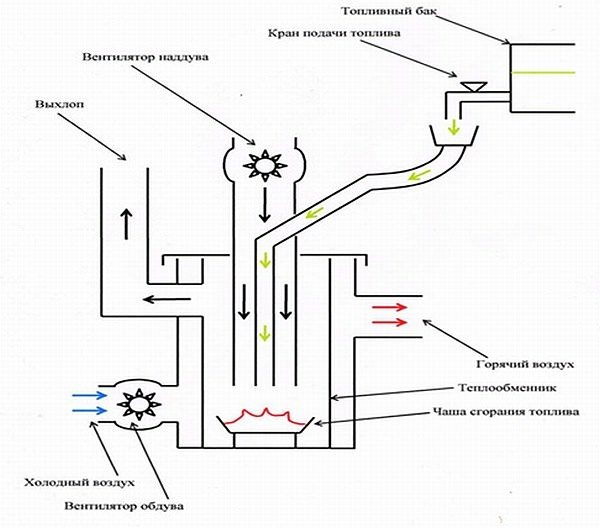

Waste oil boiler diagram
Detailed manufacturing instructions
Work on the independent production of a waste oil boiler begins with the direct preparation of building materials:
- First, cut from a pipe of a larger diameter a piece about a meter high;
- From a small diameter pipe cut off about 20 cm;
- One of the steel plates is equipped with a hole, the diameter of which should be 20 cm, and cut into the other hole depending on the diameter of the chimney;
- On both sides, the cylinder is closed using these plates and welding. This is done so that at the bottom there is a plate with a larger hole;
- Then a small cylinder is welded, the bottom of which is also welded with a plate;
- Fix the legs from the reinforcement to the body and make ventilation holes.
The result is a cylindrical structure with a small reservoir at the bottom. A door is cut from below, and the system is connected to the chimney from above. To turn on the boiler, open the door, pour waste oil into the tank and set it on fire. This is the most elementary furnace design, especially since you can often find products that are much more complex.
A standard waste oil boiler usually looks like two boxes made of fairly strong steel.They are located on top of each other and are connected using a perforated pipe. An oil filling hole is cut in the lower body, and the second metal box is connected to the chimney.
It is very easy to make such a construction more perfect: connect a supply container with used oil, a pump for its supply, a water circuit, a compressor, and so on.
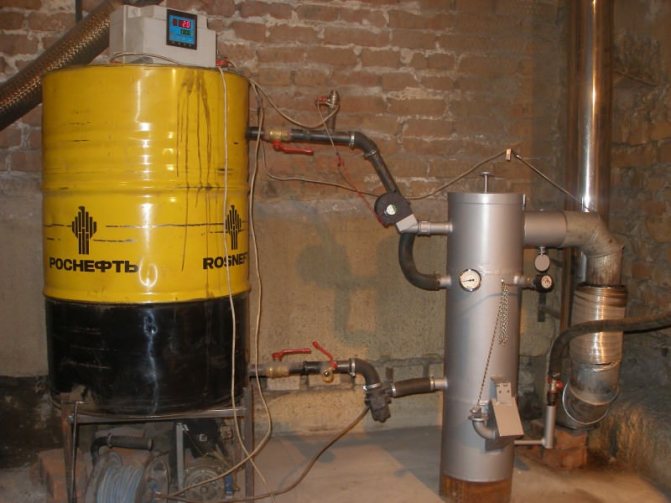

A standard waste oil boiler usually looks like two boxes made of fairly strong steel
The principle of operation of the burner during mining and its advantages
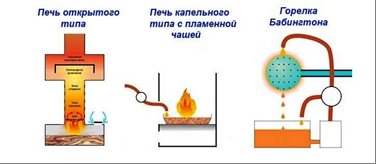

The design and principle of operation of such a device is determined by the quality characteristics of the mining products, especially the viscosity and the level of forced heating.
The burner is made of several basic elements:
- A pump for pumping mining into an evaporation unit or a chamber that prepares a liquid energy carrier.
- Coarse fuel filters - remove from it all foreign inclusions, thickened fuel oil and other suspended substances: metal, wood and stones.
- The evaporation chamber is responsible for heating the fuel to improve the quality of fuel atomization and its intensive evaporation. To regulate the heating process, there is a control device in the chamber capable of setting the temperature regime, depending on the type of fuel.
- A nozzle where the waste is mixed with air. After the burner, the air-fuel mixture goes to the furnace and where it is burned.
Advantages of a burner for fuel liquid mining:
- Simplicity of thermal design, complete absence of moving elements.
- The ability to manufacture on their own in a domestic environment.
- Availability on the Internet of the necessary technical information on various designs, with accurate drawings and calculations.
- Extremely low cost of power generation due to low mining costs.
- Highest energy efficiency.
- The small size of the burner makes it possible to integrate the model into existing heat supply sources without the need for significant reconstructions.
- Quite a high level of fire safety.
Providing drip fuel supply
This issue is one of the most difficult when assembling a waste oil boiler. The fact is that the solid impurities contained in the oil do not affect the operation of the burner in any way, however, the drip mechanism may fail due to them.
In order to get rid of such a problem, you can put an oil filter from an old car at the end of the intake hose. With its help, it is possible to achieve complete filtration of the oil. However, it should be remembered that when installing such a part, the filter element will have to be changed on average once a month.
Features of the production of a water boiler for mining
The water circuit includes the installation of piping and radiators. The most effective is the installation of a steel pipe, the diameter of which should be 43 mm, through which the heating radiators are connected. They are passed either under the finished floor or along the walls.
Assembling a waste oil boiler involves installing an expansion tank. A small container with rather thick walls is suitable for it. It is attached to the top of the boiler and connected to it by welding or bolting.
A small hole is cut out in the upper part through which hot water will go into the heating system. A pipe is also welded in the lower part, through which the cooled water will return to the boiler for further heating.
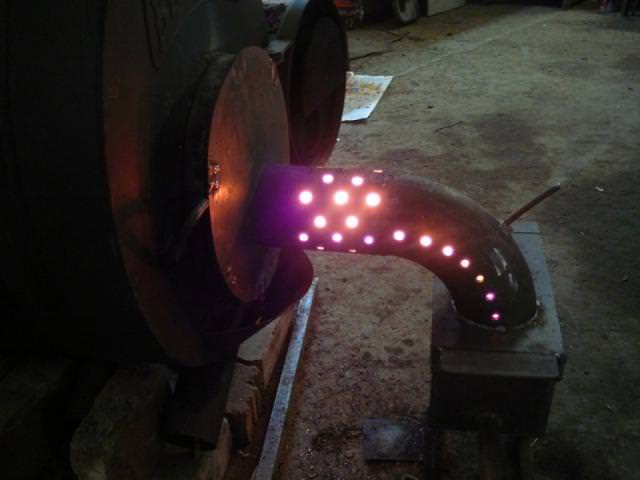

Waste oil furnace manufacturing technology
Below are the drawings of the most common working furnace.It is made from the remains of a Ø352 mm pipe, sheet steel 4 mm and 6 mm, you will also need to cut off a thick-walled Ø100 mm pipe and an angle for the legs.
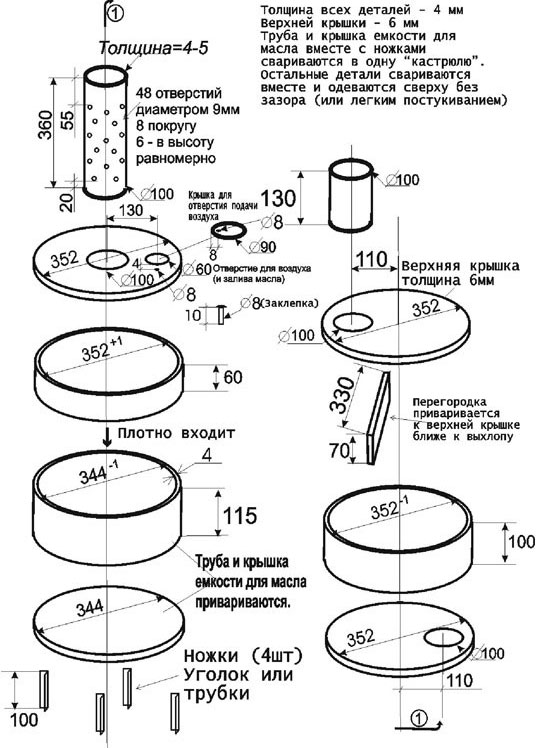

Its dimensions will allow you to heat a room with a standard ceiling height of up to 80 m2; with a larger area, the dimensions of the furnace and the diameter of the chimney should be increased.
Required tool:
- welding machine;
- grinder with a cut-off wheel;
- grinding wheel for cleaning seams;
- drill or drilling machine, drills;
- roulette.
Thinner and heat-resistant silicone paint are also needed - these are commonly sold in cans and are used to paint hot oven surfaces.
DIY manufacturing sequence:
- Prepare blanks according to the drawings. All parts are cut from the material indicated in the drawing and the cut points are cleaned to remove burrs.
- The parts of the lower tank are connected by welding: a body made of a pipe Ø344 mm h = 115 mm, a bottom made of sheet metal 4 mm, as well as legs from a corner of an arbitrary size. Instead of a corner, you can use cuttings of an inch pipe.
- In a pipe section Ø100 mm h = 360 mm, using a drill, perforation is performed according to a sketch - 48 holes with a diameter of 9 mm.
- The parts of the lower tank cover are welded together: a workpiece from a pipe Ø352 mm h = 60 mm, a cover made of sheet steel 4 mm with two holes and a perforated pipe.
- The damper for the air supply hole on the lower tank lid is riveted.
- The parts of the upper chamber are connected by welding: a workpiece from a Ø352 mm pipe h = 100 mm and a bottom made of sheet steel 4 mm with a hole for a perforated pipe.
- A chimney Ø100 mm h = 130 mm is welded to the cover of the upper chamber, on the inner side of the cover - a partition made of sheet steel 4 mm with dimensions of 70x330 mm. The partition is designed to cut off the flame and increase the heating efficiency of the upper chamber. It should be placed closer to the smoke hole.
- The upper chamber and the lid with the chimney are welded.
- The upper chamber is welded to the top of the perforated pipe; to increase the rigidity of the structure, ties can be made from a bar between the lid of the lower tank and the upper chamber.
- The upper part of the furnace is put on the lower tank in tension.
- To extend the service life, the furnace is coated with organosilicon paint, having previously cleaned the welded seams from scale, and the metal from rust using a solvent.
- Connect the stove to the chimney. Its height should be at least 4 meters to improve traction. Since the chimney will often have to be cleaned of soot, you need to make it as straight as possible, without bends.
A similar oven can be made of sheet metal, in which case its chambers will be square. Detailed technology is shown in the video.
Making a furnace for testing: video
How to connect a water circuit to the furnace for development
The water circuit is connected to a boiler installed on the upper chamber. It can be welded directly to the surface of the furnace, but it is safer to make a separate tank: if the bottom of the tank burns out, water will enter the combustion chamber, which can cause a splash of burning oil and a sharp ignition.
The tank can be of any shape and height, the main condition is a snug fit to the upper chamber and chimney for more efficient heating. Two fittings are cut into the walls of the tank: in the upper part for heated water, in the lower part for the cooled return flow.
A thermometer and a manometer are installed at the outlet of the tank. A circulation pump and an expansion tank are installed on the return pipe in the immediate vicinity of the boiler.
Operating rules
When using a waste oil boiler, certain rules must be followed. Otherwise, there may be a gas contamination of the room or even a fire.
The basic rules for using the boiler are as follows:
- The working device is prohibited leave unattended ;;
- When the boiler is on, you cannot add fuel to it;
- A boiler of this design can only burn waste oil., it is not suitable for the use of other fuels;
- Make sure that no water gets on the surface of the hot boiler., otherwise, due to a sharp cooling, it may simply burst;
- The boiler is running with a burner hole should always be open;
- Flammable and flammable substances it is strictly forbidden to keep near the boiler;
- When the boiler is on, the flap is not closedotherwise all carbon monoxide will go into the room.
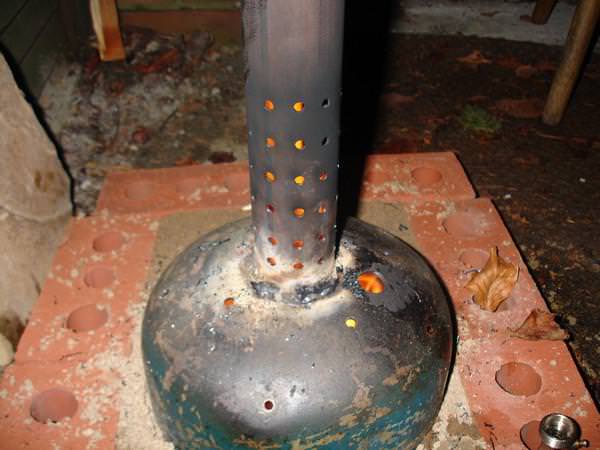

When the boiler is running, the burner hole must always be open.
Disadvantages of boilers for mining
The main disadvantage of such a device is that its reaction to shutting off the air supply to the furnace will not be instantaneous. Consequently, the combustion process will not stop immediately, but after a certain period of time, during which the heating of the coolant will continue. When the flame is completely extinguished, it will need to be re-ignited. This is done manually, if the design does not provide for any other approach.
Another drawback of the boiler during mining is its pollution in comparison with other heating devices. This is primarily due to the fuel used. If the structure is assembled correctly, then an unpleasant smell will not come from it. If the technology is violated, a similar smell will penetrate into the room to one degree or another.
Another, no less significant, disadvantage of such boilers in comparison with other designs is the need to clean the fuel from various solid impurities, which may include pieces of metal or metal shavings. If the filtration system is not adjusted, then the device will fail after a certain time, and it will be very problematic to return it to its working condition.
Pros and cons of equipment
Heating during mining has both positive and negative sides. Among the advantages, the following features should be highlighted:
- autonomy of units;
- very cheap energy resource;
- simple and reliable design;
- fast heating;
- relatively low cost of devices.
It is the independence of this type of heating that is the main advantage, which inclines many consumers towards devices for testing. However, before making a final purchase decision, you need to find out about the cons of the equipment.
The biggest disadvantage of the units is the need for frequent maintenance. For example, filters will need to be cleaned at least once a month, and it will cost to tidy up the combustion chamber twice in the same period of time. Fuel for boilers must be clean, otherwise either the efficiency will decrease, or the boiler will not work at all. Oil-powered devices can only be installed in rooms with a chimney and ventilation. And you need to be prepared for the fact that the device will emit a noticeable noise.
Blitz Tips
- Before pouring oil into the structure, it is advisable to pre-defend the mass so that no water or any other substances remain in this material. If this is not done, then during operation the device may simply go out or its operation will become unstable;
- When using such a system in the room where it is installed, there must be a fire extinguisher of the fire-acid type. This is due to the fact that if water or a similar liquid enters the surface of the structure, a fire or explosion may occur.
Turbocharged oil boilers
The device of these units is the same as that of conventional liquid fuel models. The equipment operates according to the following scheme:
- oil is supplied to the fuel compartment;
- it is sprayed into a finely dispersed suspension and injected into a combustion chamber with an elevated temperature, where it is divided into volatile and resinous substances;
- volatile compounds are mixed with the air mass and fed to the nozzle, in which they burn;
- resinous substances are heated and converted into volatiles;
- the burner turns off, but the temperature in the combustion chamber does not decrease;
- during this time, air continues to flow into the chamber and the burner is cleaned.
Models of this type are distinguished by increased sensitivity to the quality of the fuel fluid: it should not contain water or any impurities, even in small quantities.

